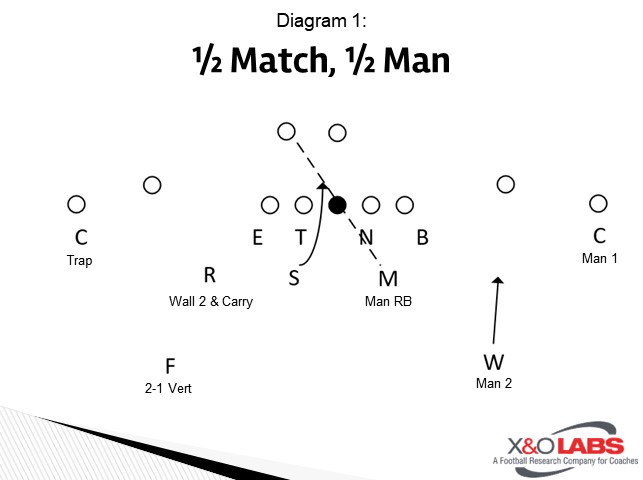By Grant Caserta
Defensive Coordinator/LBs Coach
Illinois Wesleyan University
Twitter: @gcaserta1
5-man pressures have become the go-to blitz of choice for us here at Illinois Wesleyan. Not only do they carry less risk than 6 or 7-man pressures, but they also offer the opportunity for us to be creative with our scheme, and flexible with our personnel. We can devise plays that attack weaknesses in protections and create positive matchups for us. We can be endlessly innovative with how we bring our 5 rushers. Using just a handful of techniques, we can give the offense the appearance of many different blitzes, while keeping things simple for our defensive players.
Two Read Coverage (Tex vs. 2x2)
I believe any pressure is only as good as its coverage. If there are wide open receivers running around, the ball will be out too quickly for the rush to get home. Although we have multiple different coverage options behind 5-man pressures, I will focus on just one, Tex. We will use Tex most often when blitzing one linebacker out of our 4-2 base defense. We also use it when blitzing two linebackers out of our 3-3 package. We like to use Tex for a few reasons:
- It can be used with any kind of 5-man pressure pattern involving a linebacker
- It uses coverage techniques that we already use in base coverages
- We can cover 4 verticals
- We can disguise our pressure well
In simplest terms, Tex is a combination coverage. It is like 2-read/Palms (man match) to the field and man to the boundary. There are only 4 coverage techniques involved in Tex. In our lingo, they are:
- 2-1 Vert
- Trap
- Wall 2 and Carry
- Man

2-1 Vert:
The deep safety will be the 2-1 Vert player. He is aligned 1x10 outside #2 (can be wider if there is a large split between #1 and #2). He is keying #2 to #1.
We teach all man match coverage players to look for 3 types of routes: vertical, in or out.
On a vertical route, the safety will man #2. He needs to understand there is no post help. If #2 breaks to the post, he must work to get to the top shoulder (downfield) of the WR and cut him off. If #2 breaks outside after his vertical release, the safety must maintain his outside leverage.
On an inside route (under 5 yards), the safety will rob #1. Our coaching point to the Safety when robbing #1 is to look to undercut inside breaking routes (dig, curl, slant). If #1 goes vertical, we want to take an angle to cut off the WR down the field.
On an outside route (under 5 yards), the safety will call “out, out” to the corner and man #1. The safety must take a top-down approach to #1. If his angle to #1 is too shallow, there will be no recovering on a fade/go ball.
Trap:
The corner will be the Trap player. He is aligned in outside leverage on #1, pressed up. He is also keying #2 to #1. The corner is playing #1 man to man, unless he sees #2 coming to the flat (or hears the safety call “out, out”. This is a technique that takes a lot of practice, especially if it’s being done from press alignment. Our coaching point to the corner is to keep his eyes on #1 on the initial release off the ball and steal a peek back to #2 while he is executing his press technique. As you can imagine, this takes some getting used to by the corners. However, even if the corner doesn’t see #2 coming out, he must trust his safety to make the “out” call to alert him to come off #1.
Wall 2 and Carry:
The overhang player will be the Wall 2 and Carry player. His alignment is apexed between #2 and the offensive tackle. He will key the OT for run/pass but can be late to the run. The Wall 2 and Carry player will read #2 if he gets a pass read. His responsibility will be based on the route of #2.
On a vertical route, the overhang will be a "Wall 2" player. He is going to carry #2 to about 12 yards while looking for an inside breaking route from #1. If #1 is coming inside, he will leave #2 and cover #1. If #1 does not come inside and #2 continues vertical, he will settle around 12 yards and eye the QB.
On any inside route (any depth), the overhang will carry #2 across the field. He has him, man, to man on any type of in-breaking routes (drag, slant, dig, etc). On an outside route, the overhang will rob #1. We will use the same coaching point as I mentioned when describing the safety’s “rob” technique. The main difference is we will not expect the overhang to cut off a vertical route by #1.









